
Pages:
<< Back 1
2 3 4
5 6 7
8 9 10
Next >>

________________________________
Apprentice seamen of DePauw's V-12 unit
emerging from Speech Hall at the close of
one of their regular morning assembly sessions.
____________________________________
Life
was far from normal at DePauw during wartime. Besides the Naval
trainees, there were about 900 women and less than 100 men in the
student body. Unaffiliated and freshman women were housed in Mason
Hall and the empty fraternity houses. Near the end of the war women
were also able to reside in Florence Hall, Locust Manor, and Johnson
House. Beginning in 1943 the academic calendar was revised to add
a summer term to the fall and spring semesters making it possible
to attend classes all year, in accordance with the Navy V-12 schedule.
New courses were added in meteorology, interpretation of maps, nautical
astronomy and navigation, military German, Russian and German history
and government, and "women in war." On the other hand
a few advanced courses had to be dropped for lack of enrollment,
the honors program curtailed, and a recently adopted plan for senior
comprehensive examinations postponed.
`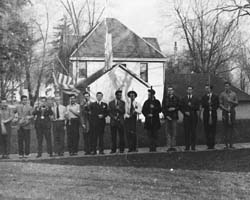
__________________________________
When the Japanese
attacked Pearl Harbor
on December 7, 1941, the men of Phi Delta Theta
lined up in the front yard to protect their country.
(Heath C. Steele 45)
_____________________________________
Women students found new opportunities to demonstrate their abilities.
For the first time coeds acted as cheerleaders at athletic events
and joined the marching band. The varsity debate team became coeducational
and was indeed composed chiefly of women during the war years. In
1943-44 a coed, Katharine Draper, served as president of the senior
class. Women were particularly numerous on the staffs of and in
leadership positions on the student newspaper, the literary magazine,
and the yearbook. The Y.W.C.A. was unusually active in wartime,
sponsoring a nursery school for underprivileged children and assisting
in the services at the Maple Heights Church in addition to its regular
programs.
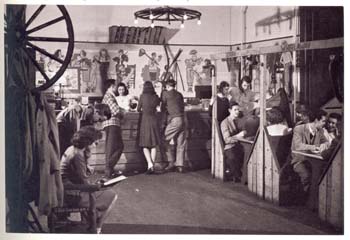
_________________________________
The Barn
for students in the 1940s did
not survive the building of the Union. In
time the location became the Faculty
Office Building and was torn down by the
early 1980s.
_________________________________
The pace of social life moderated significantly as the academic
schedule accelerated, but extracurricular activities did not come
to a complete halt. The Association of Women Students established
a social center for both Navy and civilian students in a two-story
frame building located directly across from the Carnegie Library.
Formerly known as the U Shop, it was dubbed The Barn. Dedicated
by alumnus Ford Frick following a football game in the fall of 1943,
The Barn served as a makeshift student union building into the early
postwar years.

____________________________________
Registration in Bowman
Gymnasium was always
a major ordeal each semester, often lasting several
days. This picture was taken in the late 1940s.
________________________________________
Food rationing and travel restrictions made necessary the curtailment
of activities involving parents and alumni. Old Gold Day and Dad's
Day were combined into a single holiday and Mothers' Day was omitted
after 1943 for several years. Only the 50-year alumni reunions were
celebrated at Commencement.
In May 1944 President Wildman appointed several committees in anticipation
of postwar adjustments. On the recommendation of one such committee
the Bureau of Testing and Research came into existence that fall.
Directed by Joseph Heston of the psychology department, the bureau
became responsible for freshman testing and conducted the first
guidance clinic for prospective freshmen in the summer of 1945.
Its functions were to increase greatly in the following years as
a valuable adjunct to the whole instructional process.
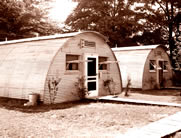 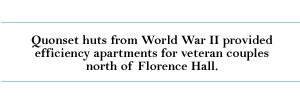
Wartime additions to the faculty included Leota C. Colpitts, who
succeeded Helen Salzer as dean of women in 1942; Edith Huggard,
who introduced courses in typing and shorthand in what became known
as the business education and later the secretarial science department;
Mary Louise Miller and Mary Steele (Callaway) in physical education;
Arthur W. Shumaker in English; Edward B. Stevens in classical languages;
and Karl T. Schlichter in art.
Others were Audrey B. Beatty in home economics; Elizabeth J. Turnell
in speech; Howard B. Burkett and Donald J. Cook in chemistry; and
Paul A. Thomas in sociology. The Music School added Patience T.
Berg, Franz Bodfors, and George W. Gove. New members of the library
staff included Audrey Knowlton, Lois E. Goan, and Grace E. Mitchell.
In 1943 Martha M. Cleavelin was named director of residence halls,
and Elsie T. DePonte (Miller) began her long DePauw career, first
as dietician and later as director of residence halls and university
food service.
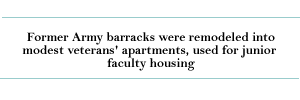 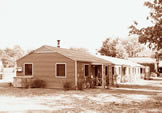
After successfully guiding the university through the war years
the Wildman administration faced another crisis immediately after
the termination of hostilities. An influx of veterans swelled enrollments,
which rose from less than 1500 to just under 2300 in two years,
straining university resources. Particularly affected was housing,
which now had to be provided for wives and children in many cases.
In 1946 six Quonset huts were erected just north of Florence Hall,
each affording two small apartments. The university
also obtained 11 former Army barracks, which were placed on Locust
Street, College Avenue, and in an area near McKim Observatory.
In addition 15 prefabricated cottages formerly occupied by the employees
of a powder plant in Wilmington, IL were relocated to the south
of the Observatory. Despite their somewhat substantial character,
most of these buildings survived the postwar veteran influx and found
later uses. In 1950 the barracks on College Avenue was converted
to a food laboratory for the home economics department and eventually
furnished quarters for both the Air Force R.O.T.C. and the International
Studies Program. The other structures continued to supply housing,
sometimes barely adequate, for married students and junior instructors
and their families for many years.
After
making do with temporary quarters in the old Florence Hall Annex
and one of the postwar Quonset huts, the art department in 1949
moved into the former Charles H. Barnaby home on East Washington
Street, a handsome two-story structure that served its new purpose
well as the University Art Center. In the same year a Quonset hut-type
building was erected near Blackstock Field for use as a storeroom
for the maintenance department.
Back
to Top
Pages:
<< Back 1
2 3 4
5 6 7
8 9 10
Next >>
|








